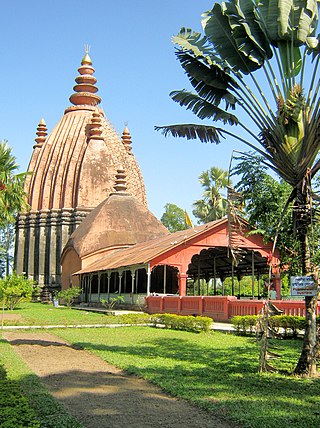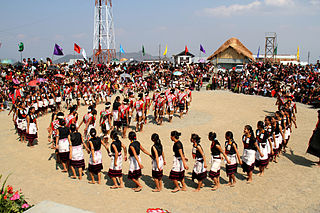Related Research Articles

Nagaland is a landlocked state in the north-eastern region of India. It is bordered by the Indian states of Arunachal Pradesh to the north, Assam to the west, Manipur to the south, and the Sagaing Region of Myanmar (Burma) to the east. Its capital city is Kohima and its largest city is the twin Chümoukedima–Dimapur. The state has an area of 16,579 square kilometres (6,401 sq mi) with a population of 1,980,602 as per the 2011 Census of India, making it one of the smallest states of India.

The Wancho people, also known as the Wancho Naga, are a Tibeto-Burmese indigenous ethnic group inhabiting the Patkai hills of Longding district in the Northeast Indian state of Arunachal Pradesh. Culturally Naga, they are ethnically related to the Nocte of Arunachal Pradesh and Konyak of Nagaland The Wancho and Konyak still today share similar names, Konyak is the largest ethnic group in Nagaland. Wancho's history is mostly based on present day Nagaland.Even today, There are villages in Wancho inhabited area in Arunachal and konyak inhabited Mon Nagaland with the same names for example Longkei village. The Wancho language belongs to the Tibeto-Burman family under Northern Naga languages.

Nagas are various ethnic groups native to northeastern India and northwestern Myanmar. The groups have similar cultures and traditions, and form the majority of population in the Indian state of Nagaland and Naga Self-Administered Zone of Myanmar (Burma); with significant populations in Manipur, Arunachal Pradesh and Assam in India; Sagaing Region and Kachin State in Myanmar. The Nagas are closely related to the neighboring Chin and Kachin people of Myanmar and northeastern India.
The Angamis are a major Naga ethnic group predominantly inhabiting the Kohima District, Chümoukedima District and Dimapur District in the Northeast Indian state of Nagaland. The Angamis are divided into four regions namely Chakhro Angami, Northern Angami, Southern Angami and Western Angami. The now separated Chakhesangs were previously known as the Eastern Angamis.
The Aos are a major Naga ethnic group native to Mokokchung District of Nagaland in Northeast India. Their main territory is from Tsüla (Dikhu) Valley in the east to Tsürang (Disai) Valley in the west in Mokokchung District.

Sivasagar district, formerly known as Sibsagar, is one of the 34 districts of Assam state in Northeast India. Sivasagar city is the administrative headquarters of this district. This historic place is also known for its rich biodiversity. The districts covers an area of 2668 square kilometers. The district comprises two sub-divisions – Sivasagar and Nazira. The district of Sivasagar lies between 26.45°N and 27.15°N latitudes and 94.25°E and 95.25°E longitudes. The district is bounded by the Brahmaputra River to the north, Nagaland to the south, the Charaideo district to the east and the Jhanji River to the west. The Sivasagar district has acquired its distinct identity due to the co-existence of different races, tribes, languages and cultures.

Longleng District (Pron:/ˈlɒŋˌlɛŋ/) is one of the eleven districts of the Indian state of Nagaland. It is the eighth least populous district in the country. The district is the home of the Phom Nagas, they are one of the major ethnic groups of Nagaland. Initially, Longleng was under the district administration of Tuensang District but later on it was bifurcated as a separate district in January 2004.
The Simte are one of the Kuki people in Northeast India. They are mainly concentrated in the southern parts of the state of Manipur. Most of the Simte are descendants of Ngaihte. Sim means South in their dialect. Simte people mainly settled in Thanlon Sub-Division, Lamka town in Churachandpur, Manipur, Motbung, Leimakhong and parts of Nagaland areas. A significant number also are settled in neighbouring areas of Mizoram and Assam. There are also Simte in Chin State in Myanmar.
The Rengma Naga are a Tibeto-Burman ethnic group inhabiting the Northeast Indian states of Nagaland and Assam. According to the 2011 Census of India, the population of Rengmas in Nagaland stands at 62,951 and the population of Rengmas in Assam is around 22,000. Tseminyü District is the headquarters of the Rengmas in Nagaland and the headquarters of the Rengmas in Assam is located at Phentsero/Karenga Village.
Yimkhiungrü, also Yachumi (Yatsumi) in Sümi, is a Sino-Tibetan language spoken in northeast India by the Yimkhiung Naga people. It is spoken between Namchik and Patkoi in Shamator District, eastern Nagaland, India. Yimkhiungrü language has more than 100,000 speakers and is used in over 100 villages and towns.

The Yimkhiungs are a Naga ethnic group inhabiting the territories of Shamator and Kiphire District in the Northeast Indian state of Nagaland and western areas of Myanmar.
The Changs are a Naga ethnic group inhabiting the Northeast Indian state of Nagaland.
The predominant religion of Nagaland is Christianity. The state's population is 1,978,502, as of 2011, out of which 87.93% are Christians. The 2011 census recorded the state's Christian population at 1,745,181, making it, with Meghalaya, Arunachal Pradesh, and Mizoram as the four Christian-majority states in India. The state has a very high church attendance rate in both urban and rural areas. Huge churches dominate the skylines of Kohima, Chümoukedima, Dimapur and Mokokchung.
Here is a list of glossary of Culture of India in alphabetical order:

Sekrenyi, also known as Sokre-n and Phousanyi, is a major annual festival of the Angami Nagas, among the many festivals held by them, in the northeast Indian state of Nagaland. It is observed for ten days from the 25th day of the Angami calendar month of "Kezei" under the auspices of the Angami Public Organisation in association with many other organizations and the state government. It is a "purification festival" held to wash off all past sins. The objective of the festival is to renew and "make holy" by cleansing the "body and the soul" of the village as a whole, and to bring forth unity among all communities of Nagaland. It also marks initiation of young people to adulthood and is considered an "identity marker of the Angami". The Christian converts among the tribals have gradually rejected these rituals.

Kigwema is a village in the southern region of Nagaland, India. It is located in Jakhama Circle of Kohima District. The village is located 15 km (9.3 mi) south of Kohima, the capital of Nagaland.
The Chirr people, are a Naga ethnic group that are mostly native to Northeast Indian state of Nagaland. They are listed as a Scheduled Tribe (STs) by India. However, due to lack of official recognition from Government of Nagaland are considered sub-tribe of Yimkhiung Nagas.

Shamator District is the 16th district of the Indian state of Nagaland. It was created on 19 January 2022 and was officially inaugurated on 4 March 2022. The district headquarter is located in the town of Shamator.
Shamator is a census town and district headquarter of Shamator district in the Indian state of Nagaland.
References
- ↑ "Census of India Website : Office of the Registrar General & Census Commissioner, India". Archived from the original on 2018-08-15. Retrieved 2021-08-05.
- ↑ "Census of India 2011". MHA, Govt of India.
- ↑ "schedule tribe Nagaland, 2001 Census" (PDF).
- ↑ "Tikhir "TSONGLAKNYI" Festival".
